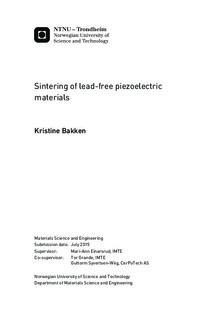Sintering of lead-free piezoelectric materials
Master thesis
Permanent lenke
http://hdl.handle.net/11250/2377302Utgivelsesdato
2015Metadata
Vis full innførselSamlinger
Sammendrag
Piezoelectric ceramics are used in many types of devices, and today, lead zirconatetitanate (PZT) dominates the market due to its superior properties. Environmentaland health concerns have made the search for lead-free piezoelectric ceramics animportant issue. Potassium sodium niobate (KNN) is a lead-free ceramic material,where good piezoelectric properties are possible through compositional engineeringor texturing, but sintering is challenging due to coarsening and alkali evaporation.
The formation of a liquid phase consisting of alkali hydroxides and carbonatesat low temperatures is proposed to be the cause of the abnormal grain growthobserved in KNN materials. A reducing atmosphere should destabilize these alkalihydroxides and carbonates, which will limit the coarsening and therefore improvethe densification and enhance the piezoelectric performance.
The effect of the sintering atmosphere in nominally stoichiometric KNN andKNN with 3 mol% nominal alkali excess was investigated. Conventional sinteringand dilatometry was conducted in synthetic air, nitrogen and a reducing atmosphere.Characterization of the sintered pellets was done by XRD, SEM, infraredspectroscopy and piezoelectric measurements.
This work confirms that the liquid phase forming in KNN materials at lowtemperatures during sintering (or calcination) consists of alkali carbonates andhydroxides. The reducing atmosphere limits the degree of coarsening and giveshigher densities. In stoichiometric KNN the coarsening was especially limited,resulting in a microstructure consisting of small cubic grains.
For piezoelectric applications, the samples had to be reoxidized, but this did notdeteriorate the microstructure significantly. The piezoelectric measurements showthat high density and proper sample preparation is important. The obtained valuesof the normalized strain and piezoelectric coefficient were generally low comparedto the reported values in the literature. The polarization loops were round and hadlarge leakage currents. However, the results suggest that a reducing atmosphereduring sintering might be beneficial for enhanced piezoelectric performance.
